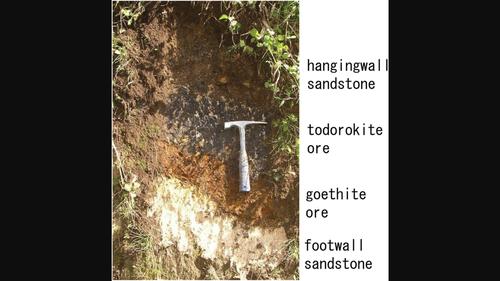Chemical compositions of the Neogene bedded manganese deposits in the Fukaura area, Northeast Japan
IF 0.8
4区 地球科学
Q3 GEOLOGY
引用次数: 0
Abstract
Inorganic chemical compositions are determined for a series of ores from three bedded manganese deposits, that is, Kitaichi, Teranosawa, and Maruyama, in the Fukaura area, northeast Japan. The deposits occur as layers or lenses conformably in sedimentary or pyroclastic rocks of the Odoji formation of the Onnagawa stage in the Neogene period. The ores are composed of lower goethite ore and upper todorokite ore. The ores in the bedded manganese deposits are anomalously high in certain elements: t‐Fe2O3 (max. 51.2%), P2O5 (0.34%), As (9200 ppm), and Pb (600 ppm) in the goethite ore, and MnO (48.5%), Ba (28,000 ppm), Co (560 ppm), Mo (660 ppm), Ni (200 ppm), Tl (32 ppm), V (530 ppm), and W (520 ppm) in the todorokite ore. In the Kitaichi profile, there is distinct compositional zoning, that is, Fe‐As‐Y, P‐Pb, Cu, Co‐W‐Tl, and Mn‐Ba‐Mo‐Sr‐V, in ascending order. Based on the occurrences and chemical compositions of the Fukaura manganese deposits and the geological and paleoceanographic backgrounds, hydrothermal input or upwelling of anaerobic stratified water would be a possible source of elements of initial ferromanganese deposits. The zoning would be made by early diagenetic redistribution process of manganese from initial Fe‐Mn deposits, left residual products of goethite ore at the original horizon. Distinct compositional zoning would be made by the different adsorption behavior of goethite and todorokite for minor elements during early diagenesis.

日本东北部福浦地区新近系层状锰矿床的化学成分
对日本东北部福浦地区北一、寺泽和丸山三层锰矿床的一系列矿石进行了无机化学成分测定。该矿床以层状或透镜状整合形态赋存于新近纪女川期Odoji组的沉积岩或火山碎屑岩中。矿石由下针铁矿矿石和上托云石矿石组成。层状锰矿床中矿石的某些元素异常高:t‐Fe2O3(最大值);针铁矿矿石中含有51.2%)、P2O5(0.34%)、As (9200 ppm)、Pb (600 ppm)和MnO(48.5%)、Ba (28000 ppm)、Co (560 ppm)、Mo (660 ppm)、Ni (200 ppm)、Tl (32 ppm)、V (530 ppm)、W (520 ppm)。北道剖面中存在明显的成分分区,依次为Fe‐As‐Y、P‐Pb、Cu、Co‐W‐Tl和Mn‐Ba‐Mo‐Sr‐V。根据福仓锰矿床的赋存状态和化学成分以及地质和古海洋学背景,热液输入或厌氧分层水上涌可能是初始锰铁矿床元素的来源。该分带是由初始Fe - Mn矿床中锰的早期成岩重分配过程和针铁矿残留产物在原层位形成的。在早期成岩作用过程中,针铁矿和翼白云岩对微量元素的吸附行为不同,形成了明显的组分分带。
本文章由计算机程序翻译,如有差异,请以英文原文为准。
求助全文
约1分钟内获得全文
求助全文
来源期刊

Resource Geology
地学-地质学
CiteScore
2.30
自引率
14.30%
发文量
18
审稿时长
12 months
期刊介绍:
Resource Geology is an international journal focusing on economic geology, geochemistry and environmental geology. Its purpose is to contribute to the promotion of earth sciences related to metallic and non-metallic mineral deposits mainly in Asia, Oceania and the Circum-Pacific region, although other parts of the world are also considered.
Launched in 1998 by the Society for Resource Geology, the journal is published quarterly in English, making it more accessible to the international geological community. The journal publishes high quality papers of interest to those engaged in research and exploration of mineral deposits.
 求助内容:
求助内容: 应助结果提醒方式:
应助结果提醒方式:


